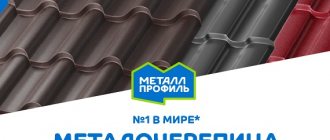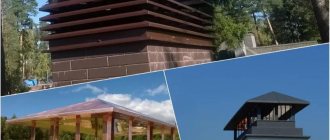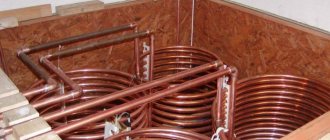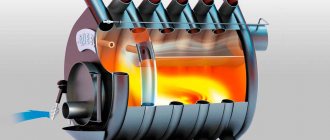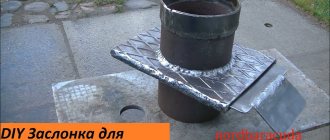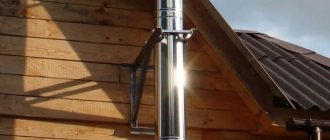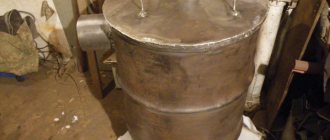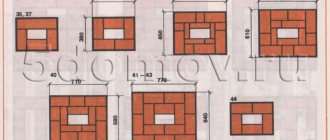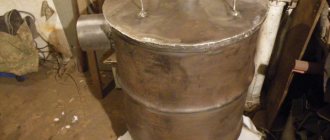It is easy to notice that many chimneys often have umbrellas installed on them. Finding the answer to the question of whether it is necessary to install a chimney cap for a gas boiler is difficult to find even on special forums, since disputes can stretch over several pages. To find the answer, you need to understand what visors are used for and what disadvantages they have.
Do I need a cap on the chimney pipe?
It seems obvious to many that a cap on the pipe is necessary.
The main task of the device is not limited to protecting the chimney from precipitation, dust and debris. The functions of the pipe umbrella include:
- protection from the so-called tipping the draft - blowing smoke back into the chimney in strong winds;
- protection against birds and small animals entering the chimney;
- extending the service life of brick or steel pipes;
- chimney decoration.
The main role of the cap is obvious - it protects the chimney from the penetration of atmospheric moisture into the heating system, which is extremely undesirable and negatively affects the operation of the boiler equipment.
But there are counterarguments against installing a cap:
- the design may interfere with the removal of smoke and combustion products from the chimney, being an obstacle to the air flow;
- the cap can reduce draft in the pipe;
- Due to the presence of water vapor in the exhaust gases in winter, ice forms on the canopy, and combustion products do not come out, but return back through the pipe in a concentrated state, poisoning the air in the room.
A cap on the chimney pipe will not interfere, provided that it is correctly selected and installed taking into account the requirements of SNiP and safety regulations.
Although some modern types of chimneys provide special devices for removing moisture and condensation, installing a wind vane on the pipe will protect the chimney from clogging and birds from entering the pipe opening.
Important! A metal cap is not an eternal design. With constant exposure to high temperatures and acidic components in fuel combustion products, thin sheet steel quickly breaks down. Depending on the device, the pipe nozzle must be changed every few years.
Is there a difference between weathervanes, chimneys and umbrellas?
Chimney caps are a general term for chimney caps. This is the name given to protective devices placed on the pipes of fireplaces, stoves, gas or diesel boilers that exhaust waste gases with smoke.
An umbrella is a broader concept. Umbrellas are suitable for both chimneys and ventilation outlets, exhaust ducts, and sewers. Their design and purpose are the same.
The caps of weather vanes are complemented by weather vanes - devices by which the direction of faith is determined. Otherwise, they are identical to smoke chambers.
An umbrella-deflector is installed on the chimney to increase draft. It increases the efficiency of the heating system, simultaneously protecting it from snow, rain, wind, debris, and other troubles.
All devices look like exhaust pipe hoods with a gable, hip, pyramidal or conical visor. The name changes only because of a slight difference in purpose.
How the hood works
The operating principle of the cap is clear: it creates a mechanical barrier to atmospheric moisture, precipitation, wind, particles in the air, and leaves. The shape of the security element is usually conical or pyramidal, i.e. pitched. This ensures free flow of water from the cap onto the roof, bypassing the chimney opening.
For this purpose, the cap device is designed in such a way that the diameter of the cap exceeds the diameter of the pipe. The base of the visor - the drip apron - partially covers the mouth of the pipe, preventing the draft from tipping over.
Varieties
The abundance of shapes and types of chimneys force manufacturers to produce caps of various shapes, styles, and sizes. In construction stores you can find the following types of products:
- Standard weather vane. Her umbrella is a pyramid made of sheet metal, attached to a drip apron using brackets.
- Four-slope weather vane. The top of such models resembles a hipped hip roof. As a rule, they are used for rectangular brick pipes.
- Wind vane with a semicircular umbrella. It is used for installation on the roofs of European-style houses. From the point of view of increasing traction, it has low efficiency, however, it looks beautiful on the slope.
- Flat weather vane. It is equipped with a flat rectangular umbrella and is used for buildings in the minimalist and modernist styles. The flat cover of the hood does not allow snow to roll off, which is why the brackets of such models experience increased load and sometimes become deformed.
- Round weather vane with a cone-shaped umbrella. They are used to protect round stainless steel pipes; such models are not equipped with a drip line.
Types of chimney caps Different types of chimney caps
Note! Wind vanes are equipped with additional functional elements: dampers, double roofs, folding doors. Don’t get carried away with elaborate details, because the main thing in choosing a deflector is durability and efficiency. An ill-conceived shape can cause noise or vibration in the pipe.
Installation technology
The main requirement of building codes is that the cap should not impede the exit of flue gases from the pipe .
To comply with it, you need to follow a number of principles:
- When the pipe is removed from the roof ridge by 1.5 meters or less, the top of the cap should rise above the ridge by at least 50 centimeters .
- When the pipe is removed from the ridge by 1.5-3 meters, the head should be on the same horizontal line .
- When the pipe is 3 meters or more away from the ridge, the head should not be below a straight line drawn from the top of the roof at an angle of 10 degrees .
- If the height of the external chimney masonry is 1.2 meters or more, then before installing the cap you need to secure the pipe with roof braces .
Most head models are prefabricated, which simplifies their installation. The general installation algorithm is standard for all additional elements: first, the main product and its additional parts are fastened, then all joints are sealed.
The head should not impede the exit of flue gases from the pipe
The lower part of the cap is installed first; it must be attached to the top of the chimney. Screws or rivets are used as fastening elements.
Next, intermediate elements and the top of the structure are installed, which are connected to each other using brackets. Rubber or silicone-based compounds are used to seal joints. Particular attention should be paid to insulating the joints of the head and chimney.
Pros and cons of a spark arrestor
Sometimes a spark arrestor is installed between the chimney and the cap. Most often, this function is performed by a metal mesh. This is true for boilers operating on solid fuel. In addition to protecting the roof and the environment from possible sparks, the mesh additionally protects the chimney from debris and does not allow birds to land on its edge.
But the spark arrestor mesh has its drawbacks. Along with the smoke, water vapor comes out as one of the elements of combustion products. Having a high temperature, in winter it condenses on the cold metal of the head and mesh, immediately turning into ice. As a result, icing of the spark arrestor prevents further smoke from escaping. Backdraft is created. Moreover, smoke and gases enter the room and can lead to poisoning. To avoid this, the grid cells must be large. But sometimes that's not enough. For boilers with high efficiency, the installation of a spark arrester should be completely eliminated.
Advantages of installing a chimney
The positive effect of an umbrella placed on a ventilation or chimney pipe will be as follows:
- rain moisture or snow will no longer get inside;
- an umbrella with wind protection for the chimney will prevent smoke and exhaust gases from blowing back into the room;
- Birds will not build a nest inside the chimney, and mice or other pests will not get in;
- the brickwork of the pipe will remain intact longer;
- a design of an unusual shape or color will decorate the roof, which is especially important if the pipe spoils the view;
- by choosing a suitable deflector, you can increase draft and heating efficiency;
- You will need to clean the chimney less often.
If the hood is placed over a pipe installed to remove odors from a country toilet, septic tank or sewer, then due to increased draft, ventilation will become more efficient.
Manufacturing technology of the Tsaga deflector with drawing
Manufacturing drawing of the Tsaga deflector.
(Click to enlarge) First, you need to decide on the dimensions of the outer and inner girth pipe. Measurements must be accurate.
The outer diameter of the stove hood fits tightly onto the chimney pipe.
The main parts are made in proportion to the internal diameter:
- the inlet pipe is placed on the pipe;
- the outer cylinder is a diffuser, its size should be approximately 30% larger than the internal diameter of the pipe;
- cover, its size should be about 90% of the pipe diameter.
In order to correctly calculate the dimensions of the deflector, a table is provided.
Please note: although the installation of a deflector or nozzle may be simple, the proportion must be maintained, and if this is disturbed, the expected result of traction will be lost. . A drawing is made on paper to match the shape and dimensions of the cap. The patterns are applied to a metal surface and cut out with metal scissors. The resulting parts must be bent according to the design and connected with rivets. The finished parts of the deflector are assembled in the workshop, and at a height they are only fixed above the pipeline.
- A drawing is made on paper to match the shape and dimensions of the cap.
- The patterns are applied to a metal surface and cut out with metal scissors.
- The resulting parts must be bent according to the design and connected with rivets.
- The finished parts of the deflector are assembled in the workshop, and at a height they are only fixed above the pipeline.
Please note: it is correct to install the smoke shaft at a height of up to 2 meters above the roof level. Remember that work carried out at height requires special care and compliance with safety regulations.
Why do pipes smoke?
- Incorrect pipe diameter selected.
- Incorrect pipe length as well as height.
- If the wind increases, cold air enters the chimney. The draft becomes less as wind pressure acts on the smoke, the smoke stops leaving the chimney and, as a result, the smoke remains in the chimney.
- The chimney is clogged with soot. You cannot use any chemicals when cleaning the chimney; to clean the chimney, you must invite a specialist.
- Perhaps a brick fell from the masonry. When strong winds rise, there are cases when bricks fall from the masonry. It is necessary to remove the brick and seal the hole with clay.
- The masonry begins to crack and cold air gets into the cracks, the draft decreases, and the fireplace will smoke. All cracks must be sealed with clay mortar.
- Condensation is released, causing the oven to become damp . Reason: when the temperature of the gases released during fuel combustion decreases. Due to the soot that accumulates on the pipe walls, it reduces the thermal insulation.
- If the chimney was built incorrectly.
- If the walls of the chimney are uneven and the cross-section of the chimney is small.
- If the chimney is installed below the roof.
- When installing a chimney near tall trees and houses.
- If the chimney passes air through the brickwork.
- If the room is poorly ventilated.
- Rain, snow.
- When it's warmer outside than in the building.
- When you light it for the first time when the chimney is frozen.
How to make a visor
First of all, you need to find out the external dimensions of the head where you plan to attach the umbrella, and then sketch out a hand-drawn sketch depicting the future structure. To develop it, use simple rules:
- the dimensions or diameter of the product must be 10 cm larger than the dimensions of the pipe, so that the edges protrude 50 mm on all sides;
- slope angle of the slopes – from 30 to 45°;
- the minimum height from the chimney cut to the fungus is 100 mm, as shown in the drawing.
In addition to the traditional umbrella, there are other design options - a deflector and a rotating weather vane - “sycophant”. The first allows you to actually increase traction due to wind pressure, which creates a vacuum inside the cylindrical body, where the smoke channel exits. But in calm weather, this device not only loses its advantages, but also worsens the traction force in the pipe, creating increased resistance at the exit of combustion products.
Deflector operation diagram
For reference. The same effect is created by rotating spherical nozzles, an example of which is shown in the picture.
The attachment is beautiful, but not very effective
A semi-cylindrical weather vane, assembled from several segments and rotating on a special bearing, was called a “sycophant” due to its ability to turn with the wind. If it were not for the high price and dubious reliability of the bearing, it would be an ideal cap for any round chimney, since it successfully protects the mouth from blowing and precipitation.
Various materials are used to make chimney canopies - thin sheet steel with zinc and polymer coating, stainless steel and even copper. To make a pipe cap with your own hands, we recommend the first 2 options - galvanized or painted metal with a thickness of at least 0.5 mm.
Making a simple round umbrella
To perform this work, you will need the usual tools - metal scissors, a drill, a hammer and a device for setting rivets. Having determined the required size of the fungus, proceed in this order:
- Screw 2 screws into the wooden strip at a distance equal to the radius of the product plus 15 mm. Get an improvised compass, with whose help mark the center of the circle on the metal and draw its outline.
- Cut the workpiece with scissors, and then draw a sector with an arc length of approximately 120 mm (the figure resembles the first piece of a round cake).
- Cut out this wedge, then forcefully align the outer edges of the circle and secure them in a vice.
- Drill 3 holes along the resulting seam and connect the ends of the part with rivets or M4 screws with nuts. The upper part of the weather vane is ready.
Drawing a circle (left) and connecting the edges of the fungus (right)
The legs for the fungus and the clamp surrounding the pipe are made of steel strips made by bending a thin sheet 2-3 times. These parts are also attached to the umbrella with rivets, which is clearly demonstrated by the master in the video:
Gable weather vane
To make this type of cap, it is advisable to use a sheet bending machine or contact the appropriate workshop for this service. In extreme cases, you will have to bend the elements manually along the line, carefully tapping the metal with a rubber hammer on a wooden block.
As in the previous version, the first step is to take the external dimensions of the brick chimney, and then calculate and sketch the pattern, as shown in the drawing. Formulas for determining the length of the sides of the elements depending on the initial dimensions of the pipe and the height of the wind vane are also given here.
What to pay attention to when installing
When installing smoke vents on the roof, you need to avoid placing the hood too low and keeping the visor close to the smoke outlet - this will reduce the draft. Small holes on the sides of the structure can lead to them freezing in winter and completely blocking the exit of exhaust gases. Freezing occurs if you heat a stove or fireplace with damp wood; when heating with gas, such cases are more rare.
If the structure is made weak or too small, it may fall into the chimney and block the chimney. This can lead to dire consequences. Especially with gas heating. The smoke of wood or coal is easily identified by smell, but when natural gas burns, it produces carbon monoxide (or carbon monoxide), which does not smell anything. It acts unnoticed - people lose consciousness, becoming increasingly poisoned.
For this reason, in Europe it is legally prohibited to install a weathervane for fireplace and stove pipes on the roof. There, these structures are permissible only for the exits of ventilation and sewer ducts, the clogging of which is unpleasant, but will not lead to death. There is no ban on chimneys in Russia, but for safety reasons it is better to trust the calculation of their sizes to professionals, or to carefully observe SNiPs.
If you make a cap from low-quality material, the smoke will quickly corrode it. Cheap galvanizing lasts no more than two to three years. Galvanized steel with a polymer coating remains unharmed much longer, and even longer - stainless steel and copper, although their price is higher.
If the ventilation and chimney are made as a single block, they are covered with gable caps so that snow can easily slide down the two slopes. In this case, the chimney outlets of boilers operating on gas or diesel fuel must be isolated from the ventilation outlets. In these cases, chimneys with additional channels are installed.
You should approach the arrangement of the chimney with the utmost thoughtfulness. In order for it to bring benefit and not harm, you need to comply with SNiPs, correct dimensions, and use reliable materials that can withstand aggressive environments. If everything is done correctly, the cap will improve the appearance of the house, optimize the chimney system and protect the pipe from destruction.
Making and installing a hood with your own hands
When assembling a simple model of a cap at home, you can do without special rolling machines, just simple tools and devices.
Required tools and materials
The set of necessary tools for the manufacture and installation of a weather vane should consist of:
- metal ruler;
- marker;
- wedge-shaped mallet;
- metal scissors;
- electric drill;
- special clamp;
- sheet bender;
- mandrels;
- small hammer.
Materials you will need:
- sheet of cardboard;
- sheet metal;
- metal plate;
- screws;
- primer for metal;
- dye.
Drawings and diagrams
A simple cap made of galvanized sheet metal 0.6 - 0.8 mm thick for a square or rectangular brick pipe can be easily made with your own hands. It has a pyramid-shaped lid and is cut using a pattern from a single sheet of metal.
For chimneys and ventilation shafts of circular cross-section, a TsAGI deflector is used. It is called so because it is an invention of the Central Aerodynamic Institute. It can be made from a sheet of thin stainless steel or galvanized steel.
You can also install a Grigorovich deflector on a round chimney.
Size calculation
The chimney must cover all planes at the end of the pipe, and if the design includes a head, then the cap must also cover its horizontal surfaces.
The future product should be quite easy to put on the pipe, so each of its length and width needs to be increased by 4-5 mm.
The wings must be of such a size that they cover the horizontal surfaces of the head.
Work progress
The process of assembling and installing the hood consists of the following steps:
- Making a pattern from cardboard according to the calculated dimensions.
- Transferring its contours to a sheet of metal and cutting out the umbrella blank using metal scissors.
- Place the workpiece on the workbench with the markings facing up, so that it is more convenient to bend first the lines marked with a dotted line in the drawing to a right angle, and then the lines marked with the letter “d”.
- Rolling a cone. The connection point must be secured with rivets.
- Making a dropper. The contours of the apron-drip parts are drawn according to the pattern on a sheet of metal and cut out. Bends along the edges of the elements are made using a sheet bender. Rivets are also used to connect parts.
- Attaching the brackets. They must first be cut from metal plates, and then welded at one end to the apron and umbrella. To treat welding areas, use a metal primer.
- Cap finishing. All surfaces of the chimney are covered with 2 layers of paint, which will protect the metal from corrosion and give the product a more aesthetic appearance.
- Installation of the cap on the head of the smoke exhaust pipe. The mounting option for the product is selected depending on the type of pipe. In some cases, screws are used or an additional clamp is installed.
Basic materials
Copper caps are the most durable
. Different metals are used to create protection for the pipe. They must be reliable, strong, not react to external environmental influences and not reduce the traction force. These materials include galvanized steel, stainless steel and copper.
Protection made of galvanized steel withstands aggressive environmental influences well and is distinguished by its practicality. Galvanized steel does not lose color when exposed to direct sunlight. It can additionally be coated with a colored polymer – polyester. If a cap made of galvanized steel with a small thickness is installed, it can burn out after 3-5 years of constant use. High temperature gases destroy it, so it is recommended to install a stainless steel reflector. The cost of the device will be higher, but the service life will increase by several decades.
Higher grade materials include stainless steel. It is durable and highly durable. Its cost is higher than galvanized steel. Can be used as an additional protective element of the cap.
Copper caps are considered the most profitable. They have a long service life that reaches 100 years. Copper goes well with gutters and other elements, and also does not lose its attractive appearance over time. Making a cap for a chimney from copper sheets is easier and more convenient. For work, a copper sheet with a thickness of 0.5 mm is selected. They are harder to work with than thin ones, but the stability of the assembled structure will be higher.
Types of ventilation hoods for the chimney and ventilation pipe
There are many types of umbrellas designed to work in different conditions. Let's look at the most common of them:
Round
These structures are designed for installation on round pipelines.
Most of them are manufactured in accordance with standard sizes, which makes them suitable for use in conjunction with ready-made ventilation or smoke ducts. They have different types of connections; the materials used for manufacturing are ordinary or stainless steel, copper.
Rectangular
These devices differ from other umbrella designs only in shape. They are designed for installation on rectangular ventilation ducts or chimneys.
In addition to standard designs, homemade umbrellas are widespread, since the shape and size of the chimney most often has its own size that does not correspond to standard products. Making an adapter in terms of labor costs is quite comparable to creating a new umbrella, so it’s easier to just make an umbrella right away.
Sewer
They are installed on sewer pipe risers and, in addition to the usual functions, help normalize the pressure in the system.
A distinctive feature of such umbrellas is the material - they are installed on polypropylene pipes, therefore they are also made from this plastic or, as an option, from PVC. The main task is to ensure the resistance of the material to UV rays and temperature changes, therefore, during manufacturing, appropriate additives are added to the plastic composition.
Ventilation
In this case, there is some confusion in the names. Ventilation hoods are installed at the beginning of exhaust lines and are designed to more effectively collect emitted pollutants, exhaust gases or excess heat during operation. They are used only indoors, functionally representing the direct opposite of outdoor umbrellas used at the exit of ventilation or smoke ducts.
Product functionality
Chimney fungi are simple devices that perform an important function. The air flows, being separated by the cap, penetrate into the channel, causing a “suction” effect. This leads to the appearance of an area where low pressure predominates. The smoke rushes in this direction. It is important to consider that air can move horizontally or at an angle.
The presence of a deflector reduces the risk of fire. To increase its efficiency, a spark arrester should be installed. It is a special mesh. The use of a canopy with a turbine allows almost any gas duct to be provided with decent thrust performance.
European cap
This model is more designed to prevent the formation of condensation and has a rounded appearance. A chimney of this type can be made independently using a steel sheet and hand-made holders.
How to make a European cap:
- Take a standard metal sheet and carefully bend it around the pipe, or directly along the contour of the chimney.
- They remake the spoons that will hold the cap directly on the pipe. It is best to do this with a special machine or ask a welder you know. You can also make transverse cuts that do not go all the way and carefully bend the strips using pliers.
- These cuts do not have to be transverse. It is permissible to use longitudinal strips if the piece of metal is quite long. A rectangle is cut out along the edges and the tails are left in the center. After this, roll the sheet in the shape of a semicircle and press the tails with a clamp.
- Gently bend the legs.
It is permissible to use a regular chimney pipe clamp to mount such a cap on the pipe.
To make a European cap, all you need is a piece of sheet metal and a grinder disc.
Choice of protection
Umbrellas can be called differently: cap, chimney, weather vane, fungus, umbrella. But the essence is the same for everyone.
First of all, you need to decide what types of chimney umbrellas exist, their shape and functionality.
- Cap for a 4-slope chimney (wind vane)
- Chimney umbrella.
- Cap (double-pitched) with gable roof.
- Pipe head cap with flat top.
- Wind vane with opening roof.
- Cap with installed weather vane.
From all the variety, you need to choose the one that will most effectively protect the pipe from debris and precipitation, and will not itself be subject to corrosion.
In addition, when choosing, you need to pay special attention to the dimensions of the structure.
If you make a mistake with the dimensions and purchase an umbrella for the chimney pipe with a larger cross-section than needed, then there is a possibility that its installation will become difficult and, as a result, it will be too low. And this threatens the occurrence of reverse thrust.
Causes of breakdowns and their elimination
There are three types of work and troubleshooting:
- Preventive maintenance
- Major renovation.
- Partial renovation.
Prevention is carried out to remove soot. No professional help needed. It is necessary to monitor all parts of the stove, clean it from soot and ash.
The stove smokes and burns poorly. It is necessary to check the draft of the stove and whether the fuel is suitable for this particular stove.
- Poor heat output from the stove . It is necessary to check how tightly the vent and the firebox door close; you need to use a special tourniquet.
- Strong draft , all the heat will go outside and the room will not warm up.
- If there is good draft , the gases will escape through the chimney and carbon monoxide will not form.
- The oven does not warm up . There are cracks in the chimney. The cracks need to be sealed. The main channel is narrowed; the narrowed channel needs to be disassembled.
- No traction. Clean the pipe using a weight. If this method fails to clean, you will have to disassemble the chimney to clean it. If the soot is from resin, then you need to light a fire in the chimney and clean it using this method; there are also chemicals.
- The stove begins to smoke . This problem occurs when the stove is constantly fired. It is necessary to disassemble the stove and repair the internal masonry of the chimney. The riser is clogged. It is necessary to disassemble the chimney closer to the clogged riser and clean it. From strong wind. Install the deflector.
- If wet spots appear on the pipe . This is the formation of condensation. Line the pipe with glass wool, do not heat the stove with raw wood or fuel, make the firebox larger, and make the entire chimney pipe much shorter.
- If after heating the stove for a long time and it still does not heat up, it is necessary to clean the chimney of soot.
- If cracks appear , then you need to cover them with a clay solution.
- After not heating for a long time , the traction will disappear. This means that there is cold air in the pipe. You need to set fire to a piece of paper, and there will be traction again.
Installation recommendations
It is important to correctly calculate the height and diameter of the cap, the height of which must be at least 10 cm from the pipe cut.
Installing a finished roof cap is quite simple if you follow safety precautions.
The structure should fit onto the chimney pipe, and not fit into it. If you leave a small gap of up to 3-4 mm, the cap will easily fit on the head. If the nozzle fits tightly and does not fluctuate with gusts of wind, there is no need to strengthen it. Otherwise, a clay or adhesive solution is used to further secure the nozzle to the pipe.
Calculation of the chimney design
When making a chimney, it is very important to carry out the correct design calculations. If you make a mistake, the “cap” will not cope with protection during snow or rain.
What to consider when calculating:
- The size of the cap must exceed the size of the chimney. Otherwise, the chimney will not be able to effectively perform its functions.
- A drainage drip is required. It organizes the discharge of sedimentary water onto the roof and then into the gutter.
- It is important to equip the weather vane with a ventilation duct, which will serve as a barrier to the condensate that forms from entering the pipe.
- If the house has a fireplace or stove, the weather vane will need a plate - a second bottom. It will protect the structure from burning, condensation, and the formation of icicles. Various materials are used for its manufacture: for stoves it is best to choose galvanized metal, and for chimneys with a high temperature of exhaust gases, copper is preferable.
- When calculating the slope, it should be taken into account that the resulting surface should have an angle of 40 degrees or more. Otherwise, a snow cap will form on the chimney in winter. However, a very large angle is also unacceptable - smoke from the chimney will not be able to escape freely.
- The efficiency of the entire structure depends on the correct calculation of the light opening.
All these six conditions must certainly be met, otherwise the smoker will not be able to perform the tasks assigned to it.
Manufacturing of the Grigorovich–Wolpert deflector
It is made by analogy with a conical cap:
- Two umbrellas are made and the edges are connected to each other. In the upper cone, cuts are made along the edges for attaching racks to them. The diameter of the cones is twice the diameter of the chimney pipe.
- The deflector has a width of 1.5 and a height of 1.6 times the diameter of the smoke channel. The outer cylinder is manufactured similarly to the diffuser cylinder. Having rolled the blanks, they are joined with rivets.
- The umbrella is connected to the diffuser using claws, and the entire structure is inserted into the outer cylinder.
